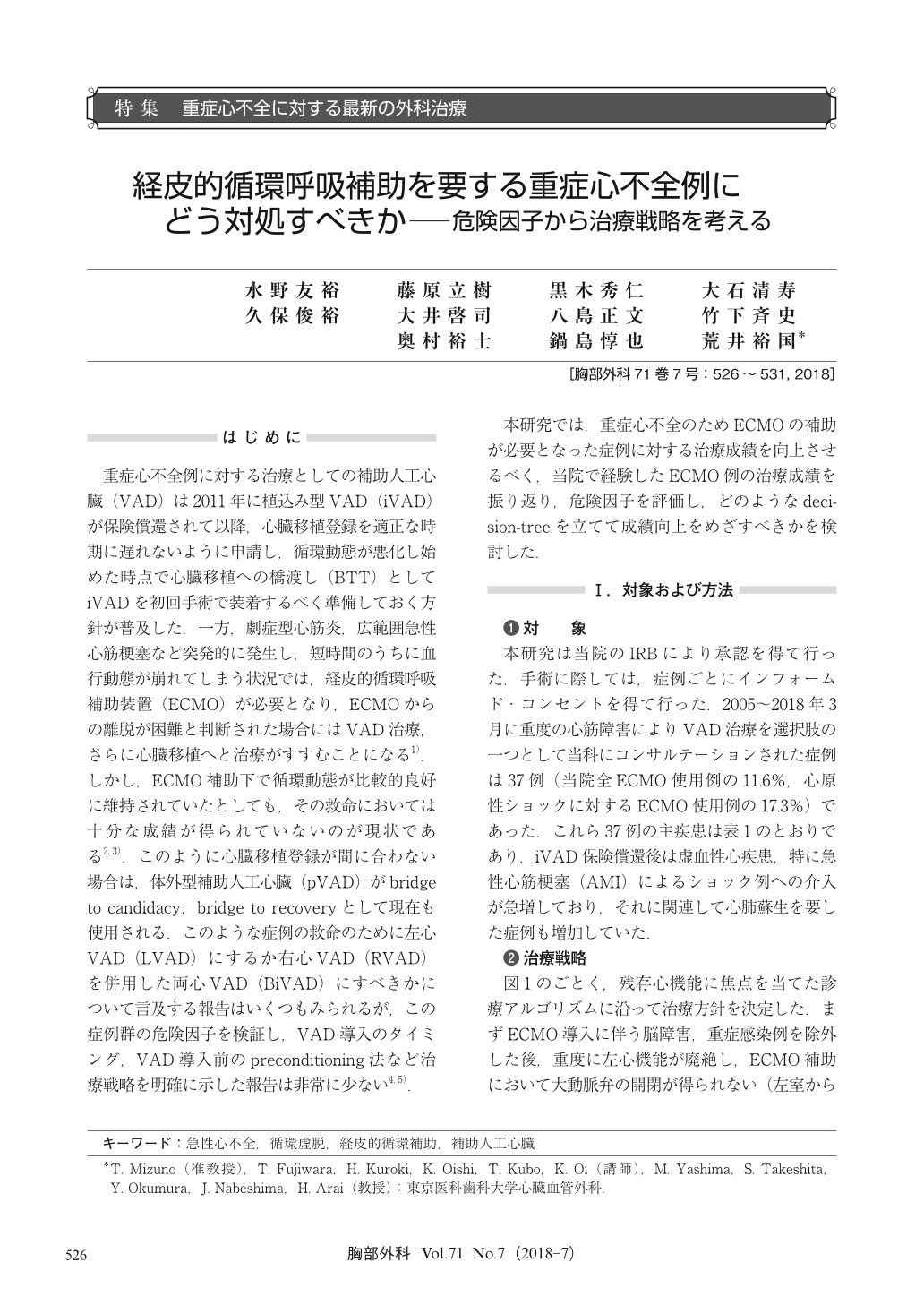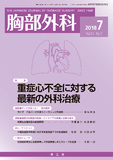Japanese
English
- 有料閲覧
- Abstract 文献概要
- 1ページ目 Look Inside
- 参考文献 Reference
重症心不全例に対する治療としての補助人工心臓(VAD)は2011年に植込み型VAD(iVAD)が保険償還されて以降,心臓移植登録を適正な時期に遅れないように申請し,循環動態が悪化し始めた時点で心臓移植への橋渡し(BTT)としてiVADを初回手術で装着するべく準備しておく方針が普及した.一方,劇症型心筋炎,広範囲急性心筋梗塞など突発的に発生し,短時間のうちに血行動態が崩れてしまう状況では,経皮的循環呼吸補助装置(ECMO)が必要となり,ECMOからの離脱が困難と判断された場合にはVAD治療,さらに心臓移植へと治療がすすむことになる1).しかし,ECMO補助下で循環動態が比較的良好に維持されていたとしても,その救命においては十分な成績が得られていないのが現状である2,3).このように心臓移植登録が間に合わない場合は,体外型補助人工心臓(pVAD)がbridge to candidacy,bridge to recoveryとして現在も使用される.このような症例の救命のために左心VAD(LVAD)にするか右心VAD(RVAD)を併用した両心VAD(BiVAD)にすべきかについて言及する報告はいくつもみられるが,この症例群の危険因子を検証し,VAD導入のタイミング,VAD導入前のpreconditioning法など治療戦略を明確に示した報告は非常に少ない4,5).
Background:Salvage rates for patients requiring extracorporeal membrane oxygenation (ECMO) due to acute cardiogenic shock remain poor due to difficulties in decision making on optical timing of ECMO removal or conversion to ventricular assist devices (VAD).
Method:From 2005 to 2018, 37 patients supported with ECMO due to acute circulatory deterioration were referred to our department for implantation of VAD. Their outcomes were analyzed using multi-variate analysis to assess the risk factors of VAD implantation, and we adopted a new decision-tree to improve the outcomes.
Results:Four patients had severe cerebral complications and 2 patients suffered severe infection. Those 6 patients were withdrawn from VAD implantation. ECMO could be removed in 6 patients, but one of them underwent VAD implantation due to the intraaortic balloon pumping (IABP) -dependent circulatory condition. In total, 25 patients underwent VAD implantation. Four patients reached to heart transplantation. Six patients remain on VAD. VAD was explanted due to recovery in 2 patients. Statistically significant risk factors by multi-variate analysis on 2-year mortality were preoperative necessity of renal replacement (p=0.006) and T-Bil (p=0.051, >4.0 mg/dl). Two-year survival of patients without end-organ dysfunction was 83.3%.However, 2-year survival of patients with end-organ dysfunction was miserable (23.1%). Based on these findings, we applied to a new decision-tree with 4 steps from 2016;①rule out strokes and sepsis, ②End-organ dysfunction should be treated before VAD implantation with proper management of mechanical circulatory support to recover end-organ dysfunction, ③urgent conversion to VAD if there is no aortic valve opening, ④conversion to VAD if cardiac functional recovery cannot be observed within 5 to 7 days. According to this decision-tree, 3 patients underwent VAD implantation after recovery from end-organ failure and survived in 2016.
Conclusions:Our experiences of salvage from ECMO in patients with severely impaired cardiac function suggest that end-organ dysfunction (necessity of renal replacement and T-Bil>4.0 mg/dl) was a strong risk factor for mid-term mortality. Those patients should undergo VAD implantation after recovery from end-organ dysfunction.

© Nankodo Co., Ltd., 2018


